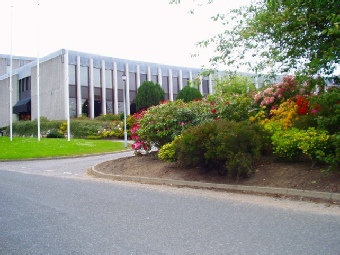

See us on
Ian Munro Webmaster

 From 1975 to 1996 Grampian Regional Council was responsible for the delivery of the major local government services – education, roads and transportation, social work, police, fire, water and sewerage, industrial development, strategic planning – to a population of half-
From 1975 to 1996 Grampian Regional Council was responsible for the delivery of the major local government services – education, roads and transportation, social work, police, fire, water and sewerage, industrial development, strategic planning – to a population of half-
The Council was established under the Local Government (Scotland) Act 1973, which introduced a two-
and 53 District Councils, plus three Island Councils replacing the previous 430 local authorities.
Grampian was the third largest of Scotland's regions covering an area of 3400 sq. miles (8700sq. kilometres) embracing the former counties of Aberdeenshire, Banffshire, Kincardine and Moray (except Grantown-
The five District Councils within the Grampian area were the City of Aberdeen, Gordon, Banff and Buchan, Moray and Kincardine and Deeside.
The headquarters of Grampian Regional Council (pictured) were at Woodhill House, Westburn Road, Aberdeen and the authority had more than 23,000 full and part-
Grampian was the only one of Scotland's nine Regional Councils where the four main political parties – Conservative, Labour, Liberal Democrat and Scottish National Party -
The Region had six Conveners (elected heads):
Councillor Sandy Mutch C.B.E., J.P. (Conservative) 1974-
Councillor John P. Sorrie C.B.E. (Conservative) 1982-
Councillor Dr Geoffrey Hadley M.B.E. (Independent), 1986-
Councillor Robert Middleton J.P. (Labour), 1990-
Councillor Rhona Kemp (Liberal Democrat), 1994-
Councillor Gordon McDonald (S.N.P.), 1995-
For its first 12 years the Council was controlled by a Conservative Administration who made a virtue of regularly levying the lowest regional rate in Scotland. The Conservatives won more than half the 53 seats on the Council in the 1974 and 1978 elections. Their majority was reduced in 1982 and in 1986 they lost control at a time when the Conservative Government in Westminster was highly unpopular in Scotland.
From 1986 to 1990 the Region's Administration was formed by a coalition of Liberal Democrats, Scottish Nationalists and Independents. From 1990-
The Region had four Chief Executives: John L. Russell O.B.E. (1974-
J. Douglas Macnaughton (1977-
Grampian was the hub of the North Sea oil and gas industry. The first oil was piped ashore at St Fergus, near Peterhead, in the year of the region's birth. The Regional Council played an important role in providing the infrastructure required to accommodate the industry.
The region was also noted for the quality of its produce – malt whisky, beef, paper, seafood, cloth and knitwear.
Grampian Regional Council was responsible for:
- The education of around 80,000 children attending more than 300 schools and 15,000 students at five further education colleges.
- The upkeep of 7400 kilometres of public road, 342 kilometres of trunk road and 130 car parks.
- Supplying around 170 megalitres of water daily – equivalent of 380 litres per consumer and maintaining 5100 kilometres of public water mains
- Protective services provided by 1200 police officers, 60 traffic wardens and 300 full-
time and 500 part- time fire- fighters. - Promoting industrial development and providing industrial sites and factory units for lease.
- Drawing up a Structure Plan to prepare for the future development of the area.
- Providing a range of caring services for families, children, elderly, and the handicapped including residential and home care services and dealing with around 12,000 social work cases a year.
In 1996 32 single tier authorities replaced Scotland’s Regional and District Councils. In Grampian the unitary councils are Aberdeen City, Aberdeenshire and Moray.
Woodhill House, © Colin Walker
Grampian Regional Council
| About GHA |
| GHA Office-bearers |
| Scots Texas |
| About Grampian |
| Grampian Region |
| Exchange Visits |
| Honours |
| Links |
| Application |
| Privacy |
| Exchange Visits 2 |
| Houston |
| About Texas |
| Houston Greeter Service |
| 2020 |
| 2019 |
| 2018 |
| 2017 |
| 2016 |
| 2015 |
| 2014 |
| 2013 |
| 2012 |
| 2011 |
| 2010 |
| GHA 2020 |
| GHA 2019 |
| GHA 2018 |
| GHA 2017 |
| GHA 2016 |
| GHA 2015 |
| GHA 2014 |
| GHA 2013 |
